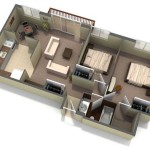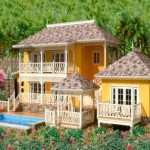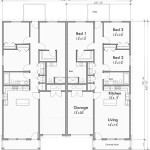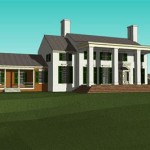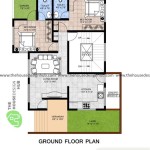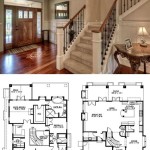Tiny House Floor Plans with Loft: Maximizing Space and Comfort
Tiny house living represents a significant shift toward minimalism and sustainable living. Choosing the right floor plan is crucial for comfortable and efficient tiny house occupancy. Among the most popular designs, tiny house floor plans incorporating a loft stand out for optimizing vertical space and creating distinct living areas within a limited footprint. This article explores various aspects of tiny house floor plans with lofts, detailing design considerations, spatial configurations, and practical applications.
Understanding the Appeal of Lofts in Tiny Houses
The primary advantage of a loft in a tiny house lies in its ability to separate sleeping quarters from the main living area. In traditional small homes, a bedroom might consume a considerable portion of the ground floor. By elevating the sleeping area to a loft, the ground floor is freed up for a more spacious living room, kitchen, and bathroom. This separation enhances the functionality and perceived spaciousness of the entire tiny house.
Furthermore, lofts can contribute to the aesthetic appeal of a tiny house. Exposed beams, well-placed windows, and thoughtful design elements can transform a loft into a cozy and inviting retreat. Natural light, in particular, plays a vital role in making the loft feel less cramped and more connected to the surrounding environment. The strategic use of skylights and dormer windows can significantly enhance the loft's ambiance.
However, potential drawbacks also exist. Access to the loft typically involves a ladder or steep stairs, which may present challenges for individuals with mobility issues. Headroom can also be a constraint, as the height of the loft space is often limited to maximize ground floor space. Careful planning and consideration of individual needs are essential when incorporating a loft into a tiny house design.
Key Design Considerations for Tiny House Lofts
Designing a tiny house loft effectively requires careful attention to several critical factors. These factors influence the usability, comfort, and overall functionality of the loft space. Failure to address these considerations adequately can result in a loft that is impractical or uncomfortable to use.
Headroom: Headroom is arguably the most important factor to consider. Building codes often dictate minimum ceiling heights for habitable spaces, but these regulations may not always apply to lofts in tiny houses, which are sometimes classified as non-habitable areas. However, even if not legally required, adequate headroom is crucial for comfort. A minimum of three to four feet of headroom above the mattress is generally recommended to allow for comfortable sitting and movement. A more generous headroom of six feet or more can transform the loft into a more versatile space, suitable for reading, working, or simply relaxing.
Access: The method of accessing the loft is another critical consideration. Ladders are the most space-efficient option, but they can be difficult and unsafe for some individuals, especially the elderly or those with mobility impairments. Stairs, while consuming more ground floor space, offer a safer and more comfortable alternative. A compromise can be achieved with alternating tread stairs or ship ladders, which provide a more gradual ascent than a ladder but take up less space than traditional stairs. The placement of the access point should also be carefully considered to minimize disruption to the ground floor layout.
Ventilation and Lighting: Adequate ventilation is essential to prevent the loft from becoming stuffy or uncomfortable. Windows, skylights, or vents can provide natural airflow and help regulate temperature. Cross-ventilation, where air can flow in through one opening and out through another, is particularly effective. Natural light is also crucial for creating a welcoming and inviting atmosphere. Skylights and dormer windows can significantly increase the amount of natural light entering the loft. Artificial lighting should also be carefully planned to provide adequate illumination for reading, working, or other activities.
Weight Distribution: The structural integrity of the tiny house must be carefully considered when designing a loft. The weight of the loft and its contents must be evenly distributed to prevent overloading any single point. This is particularly important if the tiny house is built on a trailer, where weight distribution is crucial for safe towing. Consulting with a structural engineer is highly recommended to ensure that the loft is structurally sound and can safely support the intended load.
Exploring Different Loft Configurations
The configuration of the loft can significantly impact the overall functionality and aesthetic of the tiny house. Various loft configurations cater to different needs and preferences. Some common loft configurations include:
Sleeping Loft: This is the most common type of loft, designed primarily as a sleeping area. It typically includes a bed or mattress, storage space, and often a small bedside table. The emphasis is on creating a cozy and comfortable space for sleeping and relaxing. Headroom may be limited in a sleeping loft, but the focus is on maximizing floor space below.
Storage Loft: A storage loft is designed primarily for storing belongings. It can be particularly useful for storing seasonal items, luggage, or other items that are not frequently needed. Storage lofts often have lower headroom and may be accessed via a ladder or a small staircase. Shelving and storage containers are typically incorporated to maximize storage capacity.
Living Loft: A living loft is designed as an extension of the living area, providing additional space for relaxing, reading, or working. These lofts typically have higher headroom and more natural light than sleeping or storage lofts. They may include a comfortable seating area, a desk, or a small library. Living lofts can be accessed via stairs or a more gradual staircase to facilitate easy movement and access.
Multi-Purpose Loft: A multi-purpose loft combines elements of the above configurations, serving as both a sleeping area and a living or storage space. These lofts require careful planning to ensure that all functions are adequately accommodated. Flexible furniture and storage solutions are often incorporated to maximize the loft's versatility.
Maximizing Space in a Tiny House Loft
Given the limited space available in a tiny house loft, effective space-saving strategies are essential. These strategies can help maximize the functionality and comfort of the loft while minimizing clutter and wasted space.
Built-in Storage: Incorporating built-in storage solutions, such as shelves, drawers, and cabinets, can significantly increase storage capacity without taking up valuable floor space. Built-in storage can be customized to fit the specific needs and dimensions of the loft. Integrating storage into the walls or under the bed can further optimize space utilization.
Multi-Functional Furniture: Furniture that serves multiple purposes is ideal for tiny house lofts. A futon or sofa bed can serve as both a seating area and a sleeping space. A desk that can be folded away when not in use can free up valuable floor space. Choosing furniture with built-in storage compartments can further enhance space utilization.
Vertical Organization: Utilizing vertical space is crucial in a tiny house loft. Shelving units can be used to store books, clothing, and other items. Hanging organizers can be used to store shoes, accessories, or toiletries. Utilizing the height of the loft can significantly increase storage capacity without cluttering the floor.
Minimalist Decor: Adopting a minimalist approach to decor can help create a sense of spaciousness and reduce clutter. Choosing simple, functional decorations and avoiding unnecessary items can make the loft feel more open and inviting. Light colors and natural materials can also contribute to a sense of spaciousness.
In conclusion, tiny house floor plans with lofts represent an effective strategy for maximizing space and functionality in a small living environment. Careful consideration of design elements such as headroom, access, ventilation, and weight distribution, along with the selection of appropriate loft configurations and space-saving strategies, are crucial for creating a comfortable and efficient tiny house loft. By thoughtfully planning and executing the loft design, tiny house dwellers can enjoy a living space that is both functional and aesthetically pleasing.

Tiny House Floor Plan With Bedroom Loft

Tiny House Design Floor Plans

The Mcg Loft A Tiny House With Staircase Humble Homes

10 Unique Plans Of Tiny Homes And Cabins With Loft Craft Mart

Loft Cabin Tiny House Floor Plans Small Design

Tiny House Floor Plan With Loft

Tiny House Floor Plans 32 Home On Wheels Design

8x12 31 Gif 600 409 Tiny House Floor Plans Plan With Loft

Modern Tiny House Plans

Tiny House Floor Plans Second Edition Over 350 Designs

